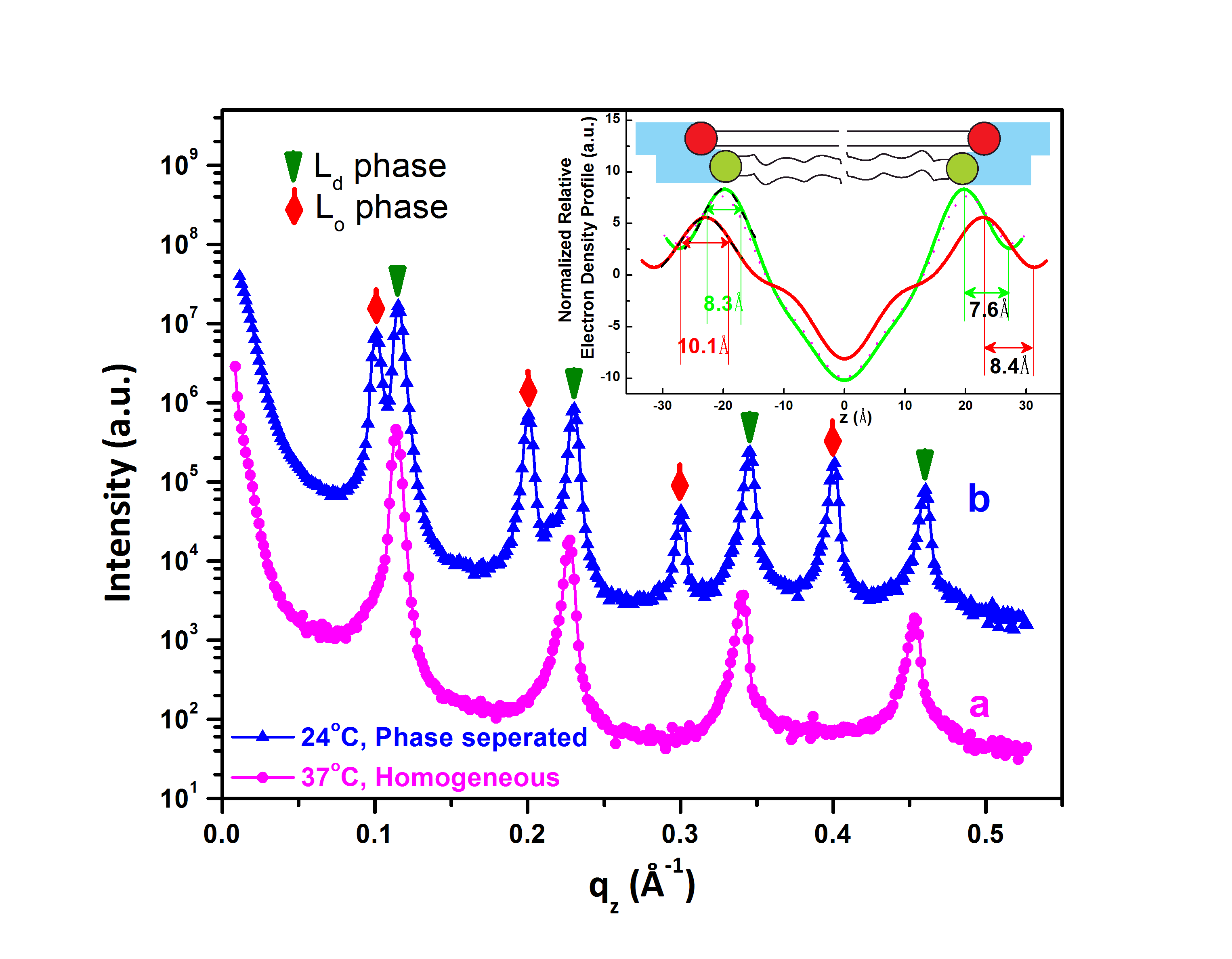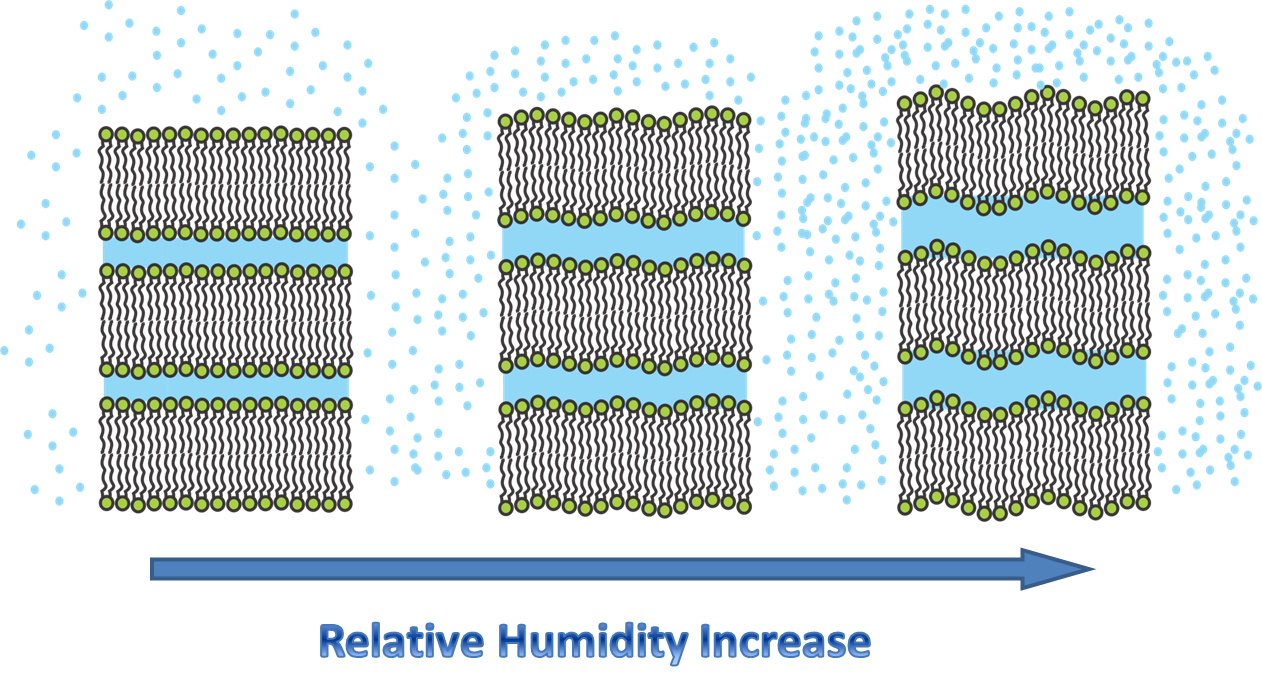1.
Ternary
mixture multilayer phase separation and domain registration study (Nature Materials COVER)
Lipid multilayer serves as a
suitable and convenient bio mimic system and was broadly used for studies of
lipid membrane structure and function. Our study shows that in addition to the
usual smectic order, ternary mixture lipid multilayer membranes can display
columnar order arising from the coupling of two-dimensional intra-layer phase
separation and inter-layer smectic ordering. This coupling propagates across
hundreds of membrane lamellae, producing long-range alignment of
phase-separated domains. Quantitative analysis of real-time dynamical
experiments of confocal florescence microscopy reveals an interplay between
intra-layer domain growth and inter-layer coupling, while X-ray reflectivity
studies resolved differences in domain structure to angstrom scale through
reconstruction of relative electron density profiles. We postulate that such
long-range coupling is solvent-assisted, and that it originates from the
surface tension associated with differences in the network of hydrogen-bonded
water molecules at the hydrated interfaces between the domains and the
surrounding phase. The understanding of this finding will open up new
opportunities and build new platform for study of phase separation and its
facilitating interactions with membrane-protein, especially beneficial for
x-ray and neutron studies.

FIG: X-ray Diffraction Analysis: X-ray scattering
profiles for a raft-forming ternary multilayer above the phase transition
temperature is in a homogeneous phase (curve a, pink) characterized by a single
set of diffraction peaks. By decreasing the temperature to below the phase
transition, a second set of diffraction peaks appears (curve b, blue), which
indicates the appearance of two separate periodicities consistent with the
inter-layer alignment of co-existing intralayer Lo and Ld
phases. The
inset shows the normalized relative electron density profile (EDP) of the unit
cell constructed from the diffraction data, with schematic drawing for the Lo
phase and Ld phase on top. The pink dotted line is the electron
density of the homogenous phase at 37C; the red line and the green line are the
EDPs for the Lo phase and the Ld phase respectively at
24C. Composition of the multilayer: 1:1
DPPC(d62)/DOPC + 16% Chol. at 98%RH.
2.
Hydration
study of DOPC multilayer under ultra-precise high humidity control (PATENT
PENDING: PI# SD2012382)
The vapor pressure paradox, since
the first report early in 1903 that gelatin uptakes less water in 100% relative
humidity (RH) vapor than in bulk water[1], has also been observed in multiple
systems and debated both theoretically and experimentally. Experimental
limitations (such as temperature gradient) and microscopic mechanisms related
to surface tension have been proposed to explain the experimental results and a
theoretical model has been established[2], but all of the experiments so far
are in either a vapor or bulk water environment. In this work, we report
measurements made while going continuously from close to 100% RH in the vapor
to bulk water.
In our newly designed experimental setup, we
were able to control the relative humidity of the sample environment from
around 98% RH to 100% RH, and continuously to bulk water through condensation.
Through X-ray diffraction/reflectivity measurements, we monitor the d-spacing
of a thousand-layer multilayer stack of Dioleoylphosphatidylcholine(DOPC) as it continuously increases with RH, while
the line-shapes for diffuse scattering indicating the increase of undulation.
More interestingly, when RH reaches 100%, membrane stacks swell to d-spacings that are much larger than the previously
reported value of 63A for DOPC in bulk water appear. This study should provide new insight and lead to important
understanding of the interplay between attractive forces such as van der Waals
and repulsive forces induced by undulations in lipid membrane system under
different boundary conditions and constrains.

FIG: Schematic of hydration study of DOPC using
our accurate humidity control between 95%~100% RH.
|
